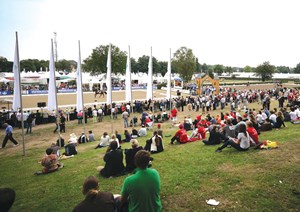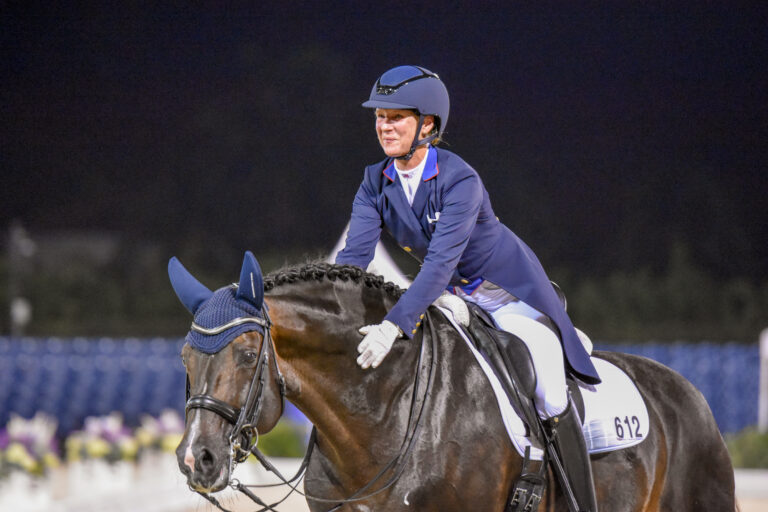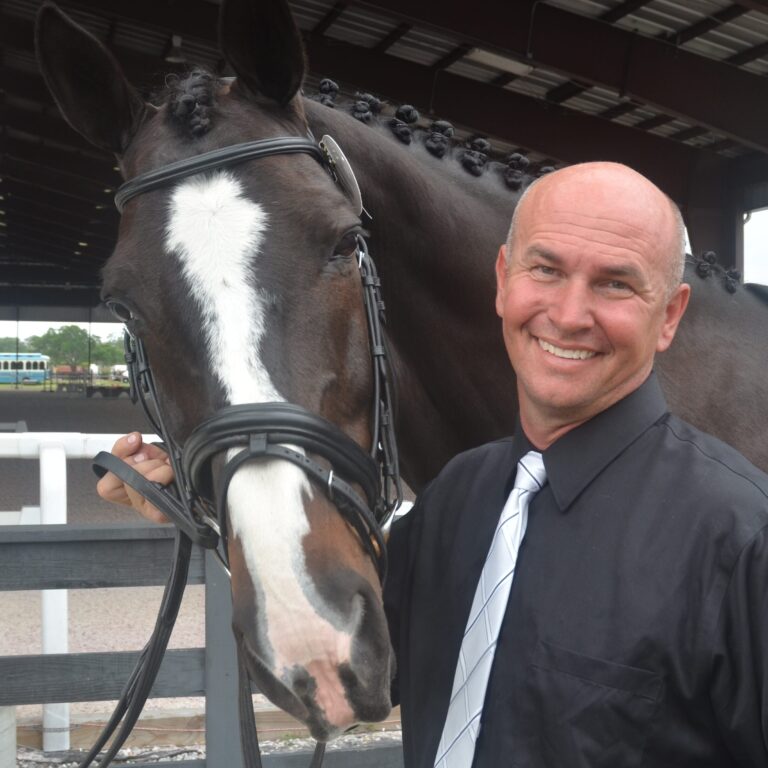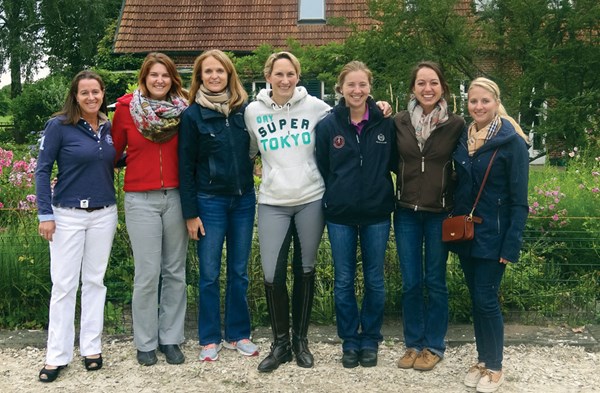
The Dressage Foundation’s Young Rider International Dream Program is designed to expose advanced Young Riders to the European training system. Each year an independent selection committee chooses four Young Riders from applicants who are between the ages of 16 and 22, have competed through at least Fourth Level and have shown a high level of commitment to the sport of dressage. This year, the dream-trip participants were Hannah Pierucci (VA and FL), Molly Eastridge (WA), Molly Maloney (NY) and Katie Foster (WI). They were chaperoned by Jennifer Baumert (NC and FL) and Jontelle Forbus (VA).
Our whirlwind trip began in England with visits to the stables of four top Olympians: First, the yard of Finnish Olympian Kyra Kyrklund. The second day we visited Laura Tomlinson (née Bechtolsheimer) and on the third, we visited Carl Hester and Charlotte Dujardin. Next, we flew to Germany for the World Breeder’s Championship at the Verden CDI. Then we spent a day with Olympian Anabel Balkenhol (daughter of Klaus Balkenhol, former trainer of the U.S. dressage team) and, finally, a day with Olympian Hubertus Schmidt. Here are 10 ideas we came home with.
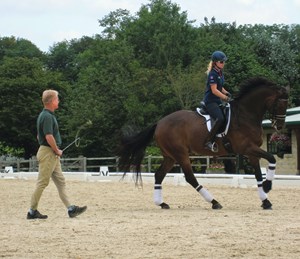
1.Patience is a virtue that must be included in everyday riding.
As we traveled to the different barns we noticed that whenever a horse was tense, the rider just waited until he was relaxed before schooling the more-difficult movements. For example, Kyra was riding a 9-year-old gelding that was nervous about changes. She made sure he was settled in the canter and waiting for her aids before asking for the change. If he anticipated and changed before she asked, she simply walked and picked up the canter again, repeating it until it was correct. She explained that it was important not to punish the horse for making a mistake in the change so as not to ruin his confidence. However, the horse got a walk break only when he made a clean flying change on the aids.
2. School pirouettes from start to finish.
Carl explained that in order to make a correct pirouette the horse must be able to do three things: canter on the spot, bend through the body and make a balanced half pass. When the horse is confirmed in these three elements, he is ready to start working the pirouettes.
The following exercise is one that Carl liked to use when starting work in the pirouettes:
1. Ride up centerline at A on the left lead.
2. As you approach C, ride a working half-pirouette to the left.
3. Continue into a half pass left.
4. When you reach the quarterline, ride another working half-pirouette to the left into another half pass.
This exercise can be repeated several times and in both directions at various speeds. Kyra explained that when a pirouette is confirmed, the degree of collection is the same as in the piaffe. She gave us a wonderful demonstration on Max, one of her Olympic horses, doing transitions between pirouette and piaffe.
3. There is more than one way to reward your horse.
Throughout our visit, we saw many ways of how to reward a horse. Often horses were rewarded with sugar after they performed a movement well. Some were allowed to stretch forward and down, especially after working on collection. Charlotte often stretched her horses to give them a break from the more collected work. Kyra rode in a half seat, allowing her horse to stretch forward. Other rewards included walk breaks and vocal praises during each of the movements.
4. Supple your horse by stretching him.
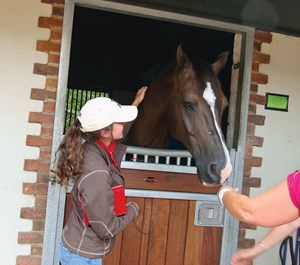
After we had visited five barns, we noted that everyone had some sort of stretch in the warm-up. Carl said that if you don’t stretch your horse, he will not be supple. You want the part of the back behind the saddle to swing and the neck to start to stretch. When this happens, you know that the horse is using himself correctly. Carl also informed us that there are different variations of stretching for different body types. In general, horses with longer backs should be stretched in a rounder frame while horses that are shorter-coupled should be stretched in a longer frame with the nose out toward the bit. Hubertus said that every horse should warm up no matter his age or level in order to make him supple and loose in the back. The overall goal is to get the feeling that the horse will stretch down at any point in the ride given the opportunity.
5.Schooling halts and transitions is invaluable.
It was impressive to see how seriously halts were taken at every barn. Every dressage test has at least two halts, making them an important movement to perfect. At some barns, the riders warmed up doing walk–halt transitions to make sure the horse was listening to the aids and was in front of the leg. But it wasn’t just at the beginning; they practiced halts throughout the whole ride. Carl taught the horses to use baby steps to become square in every halt. He said anyone and everyone should be able to come down the centerline straight, halt square and then proceed straight in every test. That’s when the judges form their first impression of you, and you really want it to stick.
At every farm, riders were doing transitions throughout the whole ride. Transitions between gaits and transitions forward and back in movements develop suppleness through the back, freedom in the movement and strength in the body. Anabel was a huge proponent of transitions forward and back within the passage to develop both the trot and passage. In addition, it is much easier to develop strength within the canter through collection and extension.
6. There are key attributes to look for when buying a young horse.
If you are looking to buy a young FEI prospect, there are key things you need to look for. Starting with the walk, two basic things need to be there: overtrack and rhythm. Although a huge overstride is technically correct, it can be very hard to teach piaffe from a large walk. As for the trot, the shape of a horse’s movement dictates what he will do in the future, and sometimes a flat-moving baby is better than a big, expressive mover. Canter is a very important gait because of the collection required in the upper levels. Remember to think about the collection needed in the pirouettes and the expression needed in the changes. It is always important to think about how the horse will feel under saddle.
7. A dull horse must learn to be quick off your leg.
We often deal with two different types of horses: those who are dull and those who are sensitive. Carl said that the most important thing to remember with a dull horse is that you need to keep your leg off so that the horse carries you. A dull horse needs to learn to be quick off your leg and he should go until you ask him to stop. If your leg is constantly on him, he will become desensitized to it. Sometimes asking a horse to gallop forward while getting off his back can help him learn the correlation between going forward and your leg aid.
8.Make piaffe easier for the claustrophobic horse.
While at Hubertus’s barn, we watched him teach a rider whose horse had trouble keeping the piaffe on the spot and staying relaxed. He helped the horse by having the rider turn while in the piaffe so that it was on the spot but the horse had a place to move. This exercise gives the horse confidence so that he is not trapped. As a result, he is able to relax within the movement.
9.There is value in every horse you ride.
Sometimes success isn’t in winning but in making the horse the best he can be and learning everything you can from him. No matter a horse’s degree of talent, you can teach him to the best of his ability, and that is success. We have to remember that not every horse can be the next Olympic Grand Prix horse, but we can always learn from him. That is what dressage is about. Not everything is perfect, but it is our job as riders to find every horse’s inner brilliance.
10.Routine is key to keeping a performance horse at the top of his game.
We saw many different ways to manage performance horses in order to keep them at the top of their game. All the farms we visited kept their horses on a strict work schedule.
The different fitness programs included working twice a day, galloping on the track, working in the aqua treadmill, hand-walking, turnout and hot walkers. The main theme was that the horses were always kept moving.
Other options for keeping horses feeling their best were icing after work, using a physical therapist and outfitting the horse in a magnetic blanket. Some barns, such as Laura’s stable, had extremely personalized feeding programs, including feeding supplements specifically tailored to an individual horse’s needs and rolling their own oats. Overall, we found the management aspect to be very interesting, and we learned a lot about how the top riders take care of their horses.
The World Breeder’s Championship for Young Horses in Verden, German
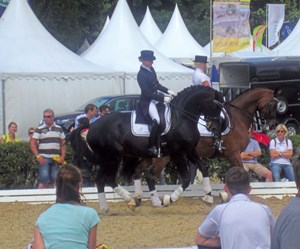
We spent three days at the World Breeder’s Championship for Young Horses in Verden, Germany. This show also had CDI classes at the Prix St. Georges and Grand Prix levels, so we were able to observe both top young horses and FEI riders.
In some ways, Verden was very different from shows in the United States. So many spectators traveled to the show and crowds of people gathered around each arena to watch. The crowds were loud and their enthusiasm for the sport was obvious.
During the Young Horse championship classes, the tents we sat in were so full that one could hardly walk around. This is very different than in the States where there are often few spectators and the crowds are very quiet.
The number of high-quality young horses that competed in the championships was also impressive. Most of the horses had large, extravagant gaits with a real ability to collect. Many were also beautifully ridden with a good connection in the bridle even at such a young age. It was fun to see how disciplined the riders were in their training and to see 5-year-old horses making smooth, simple changes of lead, square halts and correct stretch circles with ease.
Last, it was inspiring to see young professionals making their first big appearance in the international ring aboard young horses at the world championships. The Young Horse classes provide a nice stepping-stone for younger riders to get themselves noticed. This was especially interesting since we are aspiring riders ourselves.
